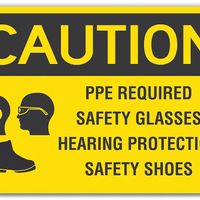Call +(254) 703 030 000 / 751 483 999 / 721 704 777
.....Read More
Frequently Asked Questions
What are the benefits of using signs and facility identification products?
Signs and facility identification products offer numerous benefits that enhance safety, efficiency, and communication within various environments. Firstly, they improve safety by providing clear instructions and warnings, helping to prevent accidents and injuries. For instance, hazard signs alert individuals to potential dangers, while exit signs guide people to safety during emergencies.
Secondly, these products enhance operational efficiency. By clearly marking areas, equipment, and pathways, they streamline navigation and reduce confusion, allowing employees and visitors to find their way quickly and efficiently. This is particularly beneficial in large facilities or complex environments like hospitals, factories, and airports.
Thirdly, signs and identification products support regulatory compliance. Many industries are subject to strict safety and operational regulations that require proper signage. Compliance with these regulations not only avoids legal penalties but also promotes a culture of safety and responsibility.
Additionally, these products facilitate effective communication. They convey essential information succinctly, ensuring that messages are understood regardless of language barriers. This is crucial in diverse workplaces or public spaces where individuals may speak different languages.
Moreover, facility identification products contribute to branding and professional appearance. Custom signs with company logos and colors reinforce brand identity and create a cohesive, professional look that can enhance customer perception and trust.
Lastly, they assist in asset management by labeling equipment and areas, making it easier to track and maintain assets. This can lead to cost savings by reducing loss and improving maintenance schedules.
In summary, signs and facility identification products are vital tools that promote safety, efficiency, compliance, communication, branding, and asset management across various settings.
How do label printers work for creating custom labels?
Label printers work by using various printing technologies to produce custom labels on demand. The most common types of label printers are thermal printers, which include direct thermal and thermal transfer printers.
Direct thermal printers use heat-sensitive paper that darkens when heated. The print head selectively heats areas of the paper to create the desired text or image. This method is simple and cost-effective but is best for short-term labels as the print can fade over time or with exposure to heat and light.
Thermal transfer printers, on the other hand, use a ribbon coated with wax, resin, or a combination of both. The print head heats the ribbon, transferring the ink onto the label material. This method produces durable, long-lasting labels suitable for various environments and applications.
Label printers can also use inkjet or laser technology. Inkjet label printers spray tiny droplets of ink onto the label material, allowing for high-resolution, full-color printing. Laser label printers use a laser beam to produce an image on a drum, which is then transferred to the label using toner. Both methods are ideal for producing high-quality, colorful labels.
To create custom labels, users typically design the label using specialized software that allows for the inclusion of text, graphics, barcodes, and other elements. The design is then sent to the printer, which processes the data and prints the label according to the specified settings.
Label printers can handle various materials, including paper, polyester, vinyl, and more, depending on the printer type and intended use. They are widely used in industries such as retail, logistics, healthcare, and manufacturing for applications ranging from product labeling to asset tracking and shipping.
What are the key features of 5S storage and labeling products?
The key features of 5S storage and labeling products are:
1. **Sort (Seiri):** This involves removing unnecessary items from the workspace. Storage products are designed to help identify and segregate essential items from non-essential ones, ensuring that only necessary tools and materials are kept.
2. **Set in Order (Seiton):** This step focuses on organizing and arranging items for easy access and efficient workflow. Labeling products play a crucial role here by providing clear, visible labels that help in categorizing and locating items quickly. Storage solutions like bins, shelves, and racks are used to systematically arrange items.
3. **Shine (Seiso):** This feature emphasizes cleanliness and regular maintenance. Storage products are often designed for easy cleaning and maintenance, ensuring that the workspace remains tidy. Labels are made durable to withstand cleaning processes without fading or peeling.
4. **Standardize (Seiketsu):** This involves creating uniform procedures and standards for storage and labeling. Products are designed to be consistent in size, color, and format, which helps in maintaining uniformity across the workspace. Standardized labels and storage solutions ensure that everyone follows the same organizational system.
5. **Sustain (Shitsuke):** The final step is about maintaining and reviewing the 5S system. Storage and labeling products are designed to be durable and adaptable, allowing for easy updates and modifications as processes evolve. This ensures long-term adherence to the 5S principles.
Overall, 5S storage and labeling products are designed to enhance efficiency, reduce waste, and improve safety by providing a structured and organized work environment.
How do safety banners and posters improve workplace safety?
Safety banners and posters play a crucial role in enhancing workplace safety by serving as constant visual reminders of safety protocols and potential hazards. They help in reinforcing the safety culture within an organization by keeping safety at the forefront of employees' minds. These visual tools are strategically placed in high-traffic areas to ensure maximum visibility and impact.
Firstly, safety banners and posters provide clear and concise information about safety procedures, emergency exits, and the proper use of equipment. This information is often presented in a straightforward manner, using bold text and vivid imagery to capture attention and facilitate quick comprehension.
Secondly, they serve as educational tools that can help in training employees, especially new hires, about the importance of adhering to safety standards. By regularly updating these materials, organizations can keep employees informed about new safety regulations and best practices.
Moreover, safety banners and posters can help in reducing workplace accidents by reminding employees to stay vigilant and cautious. They often highlight common hazards and the consequences of neglecting safety measures, thereby encouraging proactive behavior.
Additionally, these visual aids contribute to creating a positive safety culture by demonstrating the organization's commitment to employee well-being. When employees see that their safety is a priority, it can lead to increased morale and a sense of responsibility towards maintaining a safe work environment.
In summary, safety banners and posters are effective tools for improving workplace safety by providing essential information, reinforcing training, reducing accidents, and fostering a culture of safety awareness.
What are the best practices for using floor marking tape in a facility?
1. **Plan and Design**: Assess the facility layout to determine areas that require marking. Consider traffic flow, safety zones, and operational needs.
2. **Color Coding**: Use standardized color codes to convey specific messages. For example, yellow for caution, red for danger or fire equipment, green for safety equipment, and blue for mandatory actions.
3. **Durability**: Choose high-quality, durable tape that can withstand the facility's environmental conditions, such as temperature, moisture, and traffic.
4. **Surface Preparation**: Clean and dry the floor thoroughly before application to ensure the tape adheres properly. Remove any dust, grease, or debris.
5. **Application Technique**: Apply the tape in straight lines using a tape applicator for precision. Ensure there are no air bubbles or wrinkles.
6. **Visibility**: Ensure the tape is visible under various lighting conditions. Consider reflective or glow-in-the-dark options for low-light areas.
7. **Regular Maintenance**: Inspect the tape regularly for wear and tear. Replace damaged or faded tape promptly to maintain effectiveness.
8. **Employee Training**: Educate employees on the meaning of different tape colors and patterns to ensure compliance and safety.
9. **Compliance**: Ensure that the tape usage complies with relevant safety regulations and standards, such as OSHA guidelines.
10. **Flexibility**: Be prepared to adjust markings as facility needs change, such as layout modifications or process updates.
11. **Documentation**: Keep a record of the marking plan and any changes made for future reference and audits.
12. **Feedback and Improvement**: Gather feedback from employees on the effectiveness of the floor markings and make improvements as necessary.
How can utility and location marking products enhance safety and efficiency?
Utility and location marking products enhance safety and efficiency by providing clear, visible indicators of underground utilities and infrastructure. These markings help prevent accidental damage during excavation or construction activities, which can lead to service disruptions, costly repairs, and safety hazards such as gas leaks or electrical shocks. By accurately identifying the location of utilities like water, gas, electricity, and telecommunications lines, these products ensure that workers can avoid these areas, reducing the risk of accidents and injuries.
Moreover, utility marking products streamline project planning and execution. They allow for precise mapping and documentation of utility locations, facilitating better coordination among different teams and contractors. This reduces delays and increases the efficiency of construction projects by minimizing the need for rework or adjustments due to unexpected utility encounters.
In addition, these markings contribute to regulatory compliance, as many regions have laws requiring the identification of underground utilities before excavation. By adhering to these regulations, companies can avoid legal penalties and maintain their reputation for safety and reliability.
Furthermore, utility and location marking products often use color-coded systems standardized by organizations like the American Public Works Association (APWA), which enhances communication and understanding among workers and stakeholders. This standardization ensures that everyone involved in a project can quickly and accurately interpret the markings, further enhancing safety and efficiency.
Overall, utility and location marking products are essential tools in modern construction and maintenance activities, providing critical information that protects both workers and infrastructure while optimizing project timelines and costs.
What are the advantages of using stencils for marking surfaces?
Stencils offer several advantages for marking surfaces:
1. **Precision and Consistency**: Stencils ensure uniformity in design, allowing for precise replication of patterns, logos, or text across multiple surfaces. This consistency is crucial for branding and professional presentations.
2. **Time Efficiency**: Using stencils speeds up the marking process, especially for repetitive tasks. Once a stencil is created, it can be reused multiple times, saving time compared to freehand drawing or painting.
3. **Cost-Effectiveness**: Stencils reduce the need for skilled labor, as they simplify the application process. This can lower costs associated with training and labor, making it an economical choice for businesses.
4. **Versatility**: Stencils can be used on a variety of surfaces, including wood, metal, fabric, and concrete. This versatility makes them suitable for diverse applications, from industrial labeling to artistic projects.
5. **Durability**: Made from materials like plastic, metal, or cardboard, stencils are durable and can withstand repeated use. This longevity ensures that they remain a reliable tool over time.
6. **Ease of Use**: Stencils are user-friendly, requiring minimal setup and expertise. This accessibility allows individuals with varying skill levels to achieve professional results.
7. **Customization**: Stencils can be custom-made to fit specific design requirements, allowing for personalized and unique markings. This is particularly beneficial for businesses looking to maintain a distinct brand identity.
8. **Clean Application**: Stencils help prevent paint or ink from bleeding outside the desired area, ensuring clean and sharp edges. This results in a polished and professional appearance.
9. **Portability**: Lightweight and easy to transport, stencils can be used in various locations, making them ideal for on-site projects or mobile operations.
How do stamping tools differ from other marking methods?
Stamping tools differ from other marking methods in several key ways:
1. **Mechanism**: Stamping involves the use of a die or stamp to imprint a design, logo, or text onto a surface through pressure. This is distinct from methods like engraving, which removes material, or printing, which applies ink or pigment.
2. **Material Compatibility**: Stamping is particularly effective on metals and some plastics, where the material can be deformed without breaking. Other methods, like laser marking, can be used on a wider range of materials, including wood and glass.
3. **Durability**: The impressions made by stamping are typically more durable than those made by surface-level methods like printing. The indented marks are resistant to wear, making them ideal for industrial applications.
4. **Speed and Efficiency**: Stamping is a high-speed process suitable for mass production. It can produce consistent and repeatable results quickly, unlike hand engraving, which is slower and more labor-intensive.
5. **Cost**: The initial setup cost for stamping can be high due to the need for custom dies. However, once the dies are made, the cost per unit is low, making it economical for large production runs. In contrast, digital printing methods may have lower setup costs but higher per-unit costs.
6. **Precision and Detail**: Stamping can achieve high precision and detail, but it may not match the fine detail possible with laser marking or digital printing, which can produce intricate designs without physical contact.
7. **Environmental Impact**: Stamping does not involve chemicals or inks, making it a cleaner process compared to some printing methods that may require solvents or other hazardous materials.
Overall, stamping is best suited for applications requiring durable, high-volume, and cost-effective marking on compatible materials.
What materials are best for letters and numbers used in facility identification?
The best materials for letters and numbers used in facility identification are those that offer durability, visibility, and ease of maintenance. Commonly used materials include:
1. **Acrylic**: Known for its clarity and resistance to weathering, acrylic is lightweight and can be easily cut into various shapes and sizes. It is suitable for both indoor and outdoor use.
2. **Aluminum**: This material is highly durable, resistant to rust, and lightweight. Aluminum letters and numbers are ideal for outdoor signage due to their ability to withstand harsh weather conditions.
3. **Stainless Steel**: Offering a sleek, modern look, stainless steel is extremely durable and resistant to corrosion. It is often used in high-end facilities for both indoor and outdoor applications.
4. **PVC (Polyvinyl Chloride)**: PVC is a cost-effective option that is lightweight and easy to install. It is suitable for indoor use and can be used outdoors if treated with UV-resistant coatings.
5. **Brass**: Known for its classic appearance, brass is durable and resistant to tarnishing. It is often used in traditional or historic settings.
6. **Vinyl**: Vinyl decals are versatile and can be applied to various surfaces. They are best for temporary or indoor applications due to their lower durability compared to other materials.
7. **Wood**: While not as durable as metal or acrylic, wood offers a natural aesthetic. It is best used indoors or in sheltered outdoor areas.
8. **Foam**: Lightweight and easy to install, foam letters are suitable for indoor use. They can be painted or coated for added durability.
Each material has its own advantages and is chosen based on the specific requirements of the facility, such as environmental conditions, aesthetic preferences, and budget constraints.
How do signs and labels help in compliance with building codes and safety regulations?
Signs and labels play a crucial role in ensuring compliance with building codes and safety regulations by providing clear, concise, and accessible information that promotes safety and awareness. They serve several key functions:
1. **Communication of Hazards**: Signs and labels effectively communicate potential hazards, such as electrical risks, fire exits, and chemical dangers, ensuring that occupants and workers are aware of the risks and can take appropriate precautions.
2. **Guidance and Direction**: They provide essential guidance, such as evacuation routes, emergency exits, and location of safety equipment like fire extinguishers and first aid kits, facilitating quick and efficient responses during emergencies.
3. **Regulatory Compliance**: By displaying mandatory information, such as occupancy limits, building permits, and safety instructions, signs and labels help ensure that buildings comply with local, state, and federal regulations, avoiding legal penalties and enhancing safety.
4. **Standardization**: Consistent use of standardized symbols and language on signs and labels helps in universally understanding safety messages, reducing confusion and ensuring that everyone, regardless of language or literacy level, can comprehend the necessary actions.
5. **Behavioral Influence**: They encourage safe behavior by reminding individuals of safety practices, such as wearing protective gear or maintaining clear pathways, thereby reducing the likelihood of accidents and injuries.
6. **Accessibility**: Signs and labels can be designed to be accessible to individuals with disabilities, incorporating features like braille or auditory signals, ensuring that all individuals can access critical safety information.
7. **Maintenance and Inspection**: Labels on equipment and systems provide information on maintenance schedules and inspection requirements, ensuring that safety systems are regularly checked and maintained in compliance with safety standards.
In summary, signs and labels are vital tools in promoting safety, ensuring regulatory compliance, and facilitating effective communication within buildings, ultimately contributing to a safer environment for all occupants.








